In What Ways Does Religion Continue to Shape India Today
By several standard measures, Indians are highly religious. A majority of Indian adults pray daily (60%), more than two-thirds visit a house of worship at least monthly (71%), and an overwhelming share say religion is very important in their lives (84%). Previous Pew Research Center surveys show much less importance given to religion in several other regions of the world, including Western Europe, Central and Eastern Europe, Israel, Latin America and the United States. Only in sub-Saharan Africa and some regions with large Muslim populations do similar or higher shares of the public say religion is very important to them.
For many Indians, the high importance of religion is reflected in religious practices centered at home. Roughly eight-in-ten Indian adults (81%) have an altar, shrine or religious symbol in their home for worship, and a similar share (78%) say they have invited a religious leader to conduct religious rites at their home. These home-based religious practices are widely followed among both Hindus and members of smaller religious communities.
Some other religious and spiritual practices, though, are much less common. For instance, while yoga is strongly promoted by the Indian government as a core Indian practice, 62% of Indians report never practicing yoga. Scripture reading is also not as common: Most Indian adults (58%) say they read or listen to recitation of scripture either on a yearly basis or less often than that, including about one-in-five (22%) who say they never do this.
Buddhists are the least likely group to engage in many of these religious practices. And Southern Indians are often less observant than other Indians by these measures.
Several of the religious practices covered in the survey are common among Hindus regardless of demographic background or political preference. But among Hindus, nationalist attitudes and support for the Bharatiya Janata Party (BJP) are connected with somewhat higher levels of religious practice. For example, those who say it is very important to be Hindu to be truly Indian are more likely than other Hindus to meditate at least weekly (55% vs. 35%). And Hindus who have a favorable view of the BJP are more likely than those who have an unfavorable view of the party to say they have received purification by taking a dip in a holy body of water, such as the Ganges River (68% vs. 58%).
Southern Indians least likely to say religion is very important in their life
 Indians overwhelmingly say that religion is very important in their lives (84%), including majorities in each of the country's major religious groups. Christians are the least likely religious community to feel religion plays a very important role in their personal lives, but still, fully three-quarters (76%) say this is the case. And most others, both among Christians and the population as a whole, say religion is "somewhat" important to them; just 3% of Indian adults say religion is "not too" or "not at all" important in their lives.
Indians overwhelmingly say that religion is very important in their lives (84%), including majorities in each of the country's major religious groups. Christians are the least likely religious community to feel religion plays a very important role in their personal lives, but still, fully three-quarters (76%) say this is the case. And most others, both among Christians and the population as a whole, say religion is "somewhat" important to them; just 3% of Indian adults say religion is "not too" or "not at all" important in their lives.
Roughly nine-in-ten Indians in the country's Central region (92%) say religion is very important to them, while far fewer Southern Indians (69%) feel this way. And rural Indians are somewhat more likely than those who live in cities to place great importance on religion (86% vs. 81%).
College graduates are modestly less likely than other Indians to say religion has high importance in their life (80% vs. 85%).
Indians regularly visit their houses of worship
The survey, conducted before the Indian government began imposing lockdowns in response to the COVID-19 outbreak, asked Indians how frequently they visit religious sites or houses of worship. Hindus, Buddhists and Jains were asked about visiting temples; Muslims about visiting mosques for namaz; Sikhs about visiting gurdwaras; and all other respondents, including Christians, about attending religious services. Most Indians (71%) say they visit these religious sites at least once a month. (The survey also asked people if they have prayed, meditated or performed a ritual at houses of worship outside of their own religious group; see Chapter 2.)
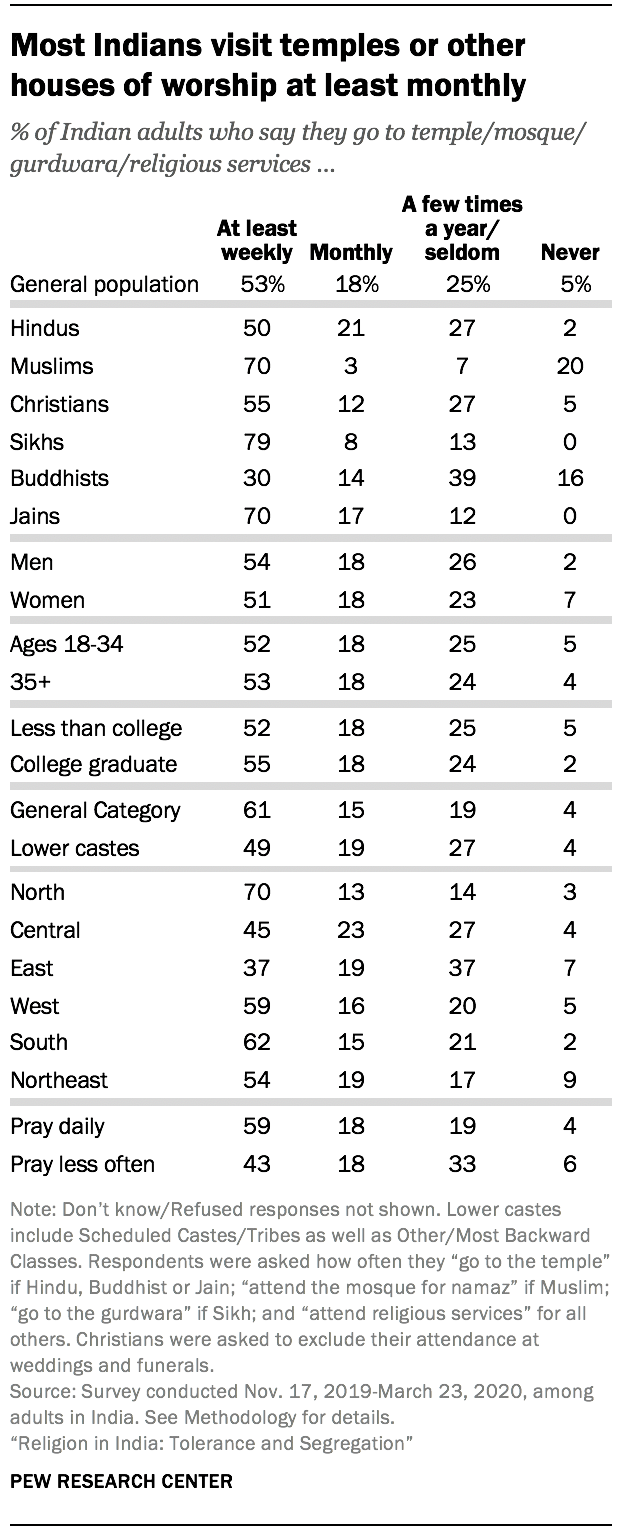 Large majorities in every major religious community – with the exception of Buddhists – say they visit a house of worship at least monthly. And majorities in nearly all these groups even do so on a weekly basis. For example, 87% of Jains go to a temple at least monthly, including 70% who visit the temple at least once a week.
Large majorities in every major religious community – with the exception of Buddhists – say they visit a house of worship at least monthly. And majorities in nearly all these groups even do so on a weekly basis. For example, 87% of Jains go to a temple at least monthly, including 70% who visit the temple at least once a week.
Fewer than half of India's Buddhists (44%) visit temples at least monthly. And Buddhists are also among the most likely to report never visiting their house of worship (16%). A similar share of Muslims (20%) say they never go to a mosque for namaz, but this is almost entirely driven by Muslim women – fully 41% of whom report never visiting a mosque, compared with just 1% of Muslim men.
Among Indians overall, however, gender, age and education have little connection to how often people report attending their house of worship. But members of General Category castes are more likely than Indians from lower castes to visit their religion's sites at least monthly (77% vs. 68%).
Visiting a temple, mosque, gurdwara or religious service also is more common among Indians who are more religious in other ways. For example, Indians who say they pray daily are more likely than other Indians to visit religious sites at least monthly (77% vs. 62%).
Most Indians give to charitable causes
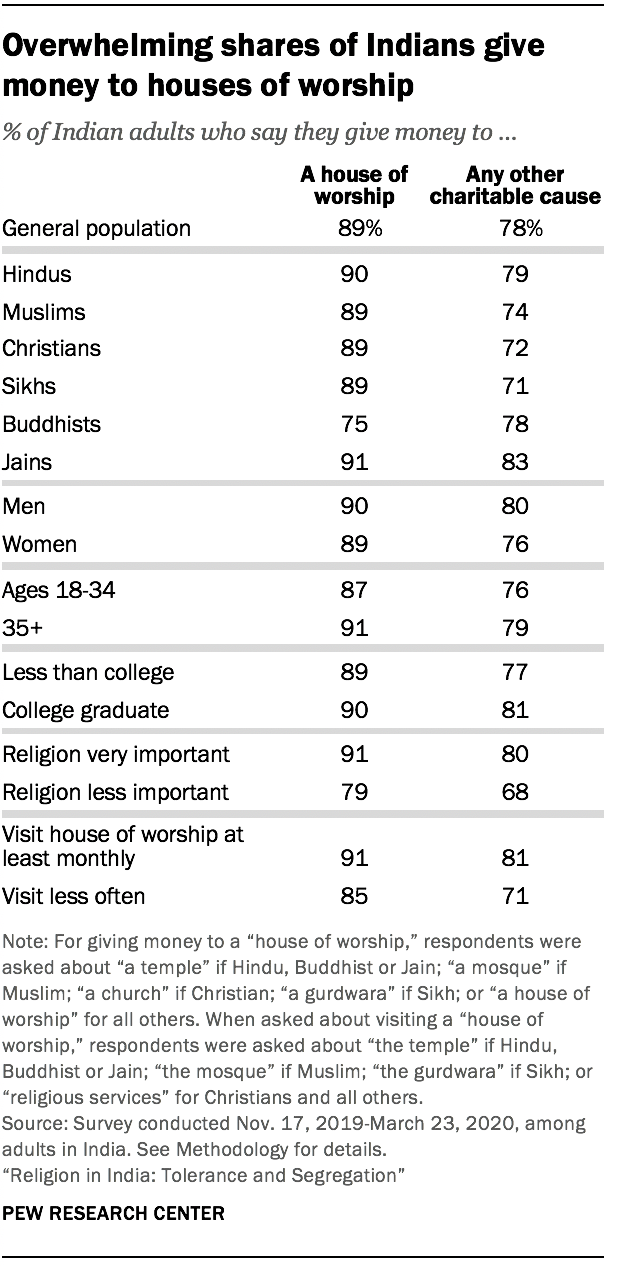 While most Indians visit a house of worship monthly or more often, even larger shares report donating money to these venues. Nearly nine-in-ten Indians (89%), including nearly identical shares across most religious groups, say they give money to a house of worship associated with their religion. Even among Buddhists, who have the lowest rate of monthly temple attendance (44%), three-quarters of adults say they give money to temples.
While most Indians visit a house of worship monthly or more often, even larger shares report donating money to these venues. Nearly nine-in-ten Indians (89%), including nearly identical shares across most religious groups, say they give money to a house of worship associated with their religion. Even among Buddhists, who have the lowest rate of monthly temple attendance (44%), three-quarters of adults say they give money to temples.
Indians also overwhelmingly give to other charities. About eight-in-ten Indian adults (78%) say they give money to charitable causes other than their house of worship.
Among Muslims, those with a college education are more inclined than less-educated Muslims to give money to charitable causes aside from the mosque (87% vs. 73%).
Among Indians as a whole, higher levels of religious observance are connected with giving money not only to a house of worship, but also to other charities. For example, 80% of Indians who say religion is very important to their lives donate money to charities other than their house of worship, compared with 68% among those for whom religion is less important.
Majorities of Hindus, Muslims, Christians and Jains in India pray daily
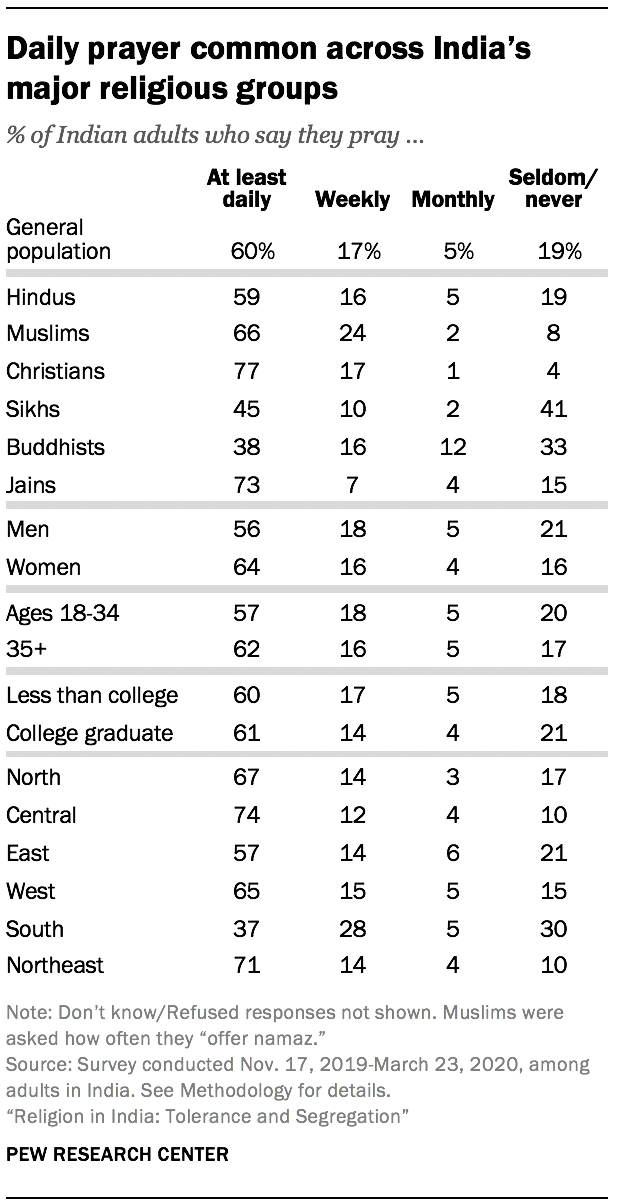 Six-in-ten Indians say they pray daily, including 18% of Indians who say they pray several times a day.18
Six-in-ten Indians say they pray daily, including 18% of Indians who say they pray several times a day.18
But prayer practices vary widely in India. Large majorities of Christians (77%) and Jains (73%), for example, pray at least once a day, while far fewer Sikhs (45%) and Buddhists (38%) do so.
Nationally, women are more inclined than men to pray daily (64% vs. 56%). And adults ages 35 and older are slightly more likely to offer daily prayers or namaz than are younger adults (62% vs. 57%). People of different education levels, however, pray daily at similar rates.
The frequency of prayer differs considerably by region – from 37% in the South saying they pray daily to about three-quarters in the Central region (74%). The low rate of daily prayer in the South is driven by the region's Hindus: Southern Muslims and Christians pray at similar rates to their national counterparts, but Southern Hindus are much less likely to pray daily than Hindus nationally (30% vs. 59%).
Indians who say religion is very important in their lives are more likely than others to pray daily (63% vs. 45%).
Among Sikhs and Buddhists – the groups least likely to pray daily – prayer is more common among those who recently faced financial hardship. For example, Buddhists who recently struggled to pay for the basic necessities of food, medical care or housing are more likely than other Buddhists to pray daily (48% vs. 32%).
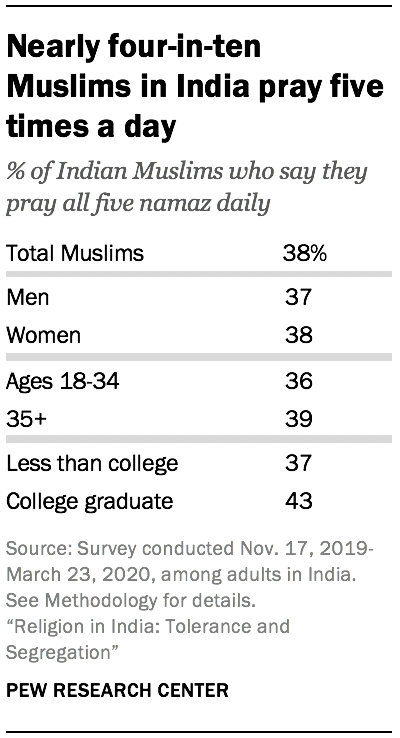 About four-in-ten Muslims (38%) say they pray all five namaz daily; this figure is similar across different age groups, education levels and castes. And while Indian women nationally pray daily at higher rates than men, Muslim men (37%) are just as likely as women (38%) to pray all five namaz.
About four-in-ten Muslims (38%) say they pray all five namaz daily; this figure is similar across different age groups, education levels and castes. And while Indian women nationally pray daily at higher rates than men, Muslim men (37%) are just as likely as women (38%) to pray all five namaz.
More Indians practice puja at home than at temple
 Puja is a practice that often involves prayer and giving offerings to deities. The survey asked Hindus, Sikhs, Buddhists and Jains how frequently they perform this ritual at home and at a temple. Majorities of Jains (83%), Hindus (76%) and Buddhists (58%) practice puja at home at least once a week. In fact, the vast majority of Jains (79%) say they perform puja at home daily.
Puja is a practice that often involves prayer and giving offerings to deities. The survey asked Hindus, Sikhs, Buddhists and Jains how frequently they perform this ritual at home and at a temple. Majorities of Jains (83%), Hindus (76%) and Buddhists (58%) practice puja at home at least once a week. In fact, the vast majority of Jains (79%) say they perform puja at home daily.
Across religious groups, people perform puja at home more often than they do at a temple. For example, while about three-in-four Hindus (76%) practice puja at home weekly, roughly half (53%) do so at a temple each week.
Sikhs are less likely than other groups to report performing puja at least weekly at home (40%) or at a temple (21%).
Among Hindus, women are much more likely than men to perform puja in their home at least weekly (84% vs. 68%). But the shares of Hindu women and men who perform puja at temples are more similar (55% and 51%, respectively).
Hindus in the Eastern region of India are generally less likely than Hindus elsewhere to practice puja at home or at temple on a weekly basis. And lower-caste Hindus are less inclined than General Category Hindus to perform puja.
Most Hindus do not read or listen to religious books frequently
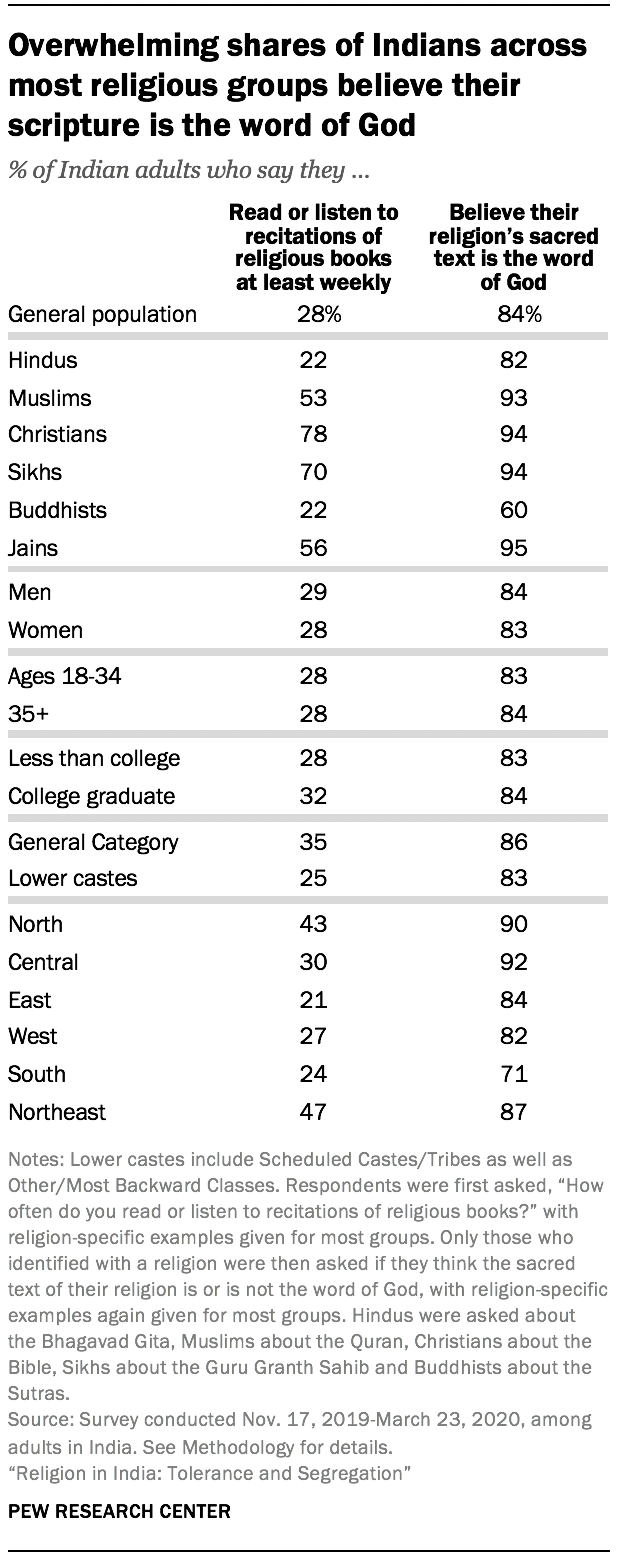 The survey asked Indians how often they read or listen to recitations of religious books. For most of the religious communities, an example of a religious text was included in the question: Hindus were asked about the Bhagavad Gita, Muslims about the Quran, Christians about the Bible, Sikhs about the Guru Granth Sahib and Buddhists about the Sutras. (Jains were not given an example of a specific text.)
The survey asked Indians how often they read or listen to recitations of religious books. For most of the religious communities, an example of a religious text was included in the question: Hindus were asked about the Bhagavad Gita, Muslims about the Quran, Christians about the Bible, Sikhs about the Guru Granth Sahib and Buddhists about the Sutras. (Jains were not given an example of a specific text.)
While large majorities of Christians (78%) and Sikhs (70%) say they read scriptures at least weekly, and over half of Jains (56%) and Muslims (53%) do this as well, fewer Hindus and Buddhists (22% each) read or listen to religious books with such regularity.
Among Hindus, reading or listening to recitations of religious books at least weekly is more common among people belonging to upper castes (29%) than among people who belong to lower castes (19%). Highly educated Hindus are also somewhat more likely than their less-educated peers to read or listen to recitations of religious texts.
In every community, though, the majority believes their religion's sacred text is the word of God. And in each case, the share who say their religious texts are the word of God is substantially higher than the share who read or listen to these texts at least weekly. For example, 82% of Hindus say the Bhagavad Gita is the word of God; 22% read it every week.
Southern Indians are the least likely to say their sacred text is the word of God (71%), with Hindus driving this pattern. Two-thirds of Southern Hindus say the Bhagavad Gita is the word of God (67%), compared with 82% of all Indian Hindus. But nearly all Muslims (94%) and Christians (96%) in the South say their sacred text is the word of God, just like Muslims (93%) and Christians (94%) nationally.
Most Indians have an altar or shrine in their home for worship
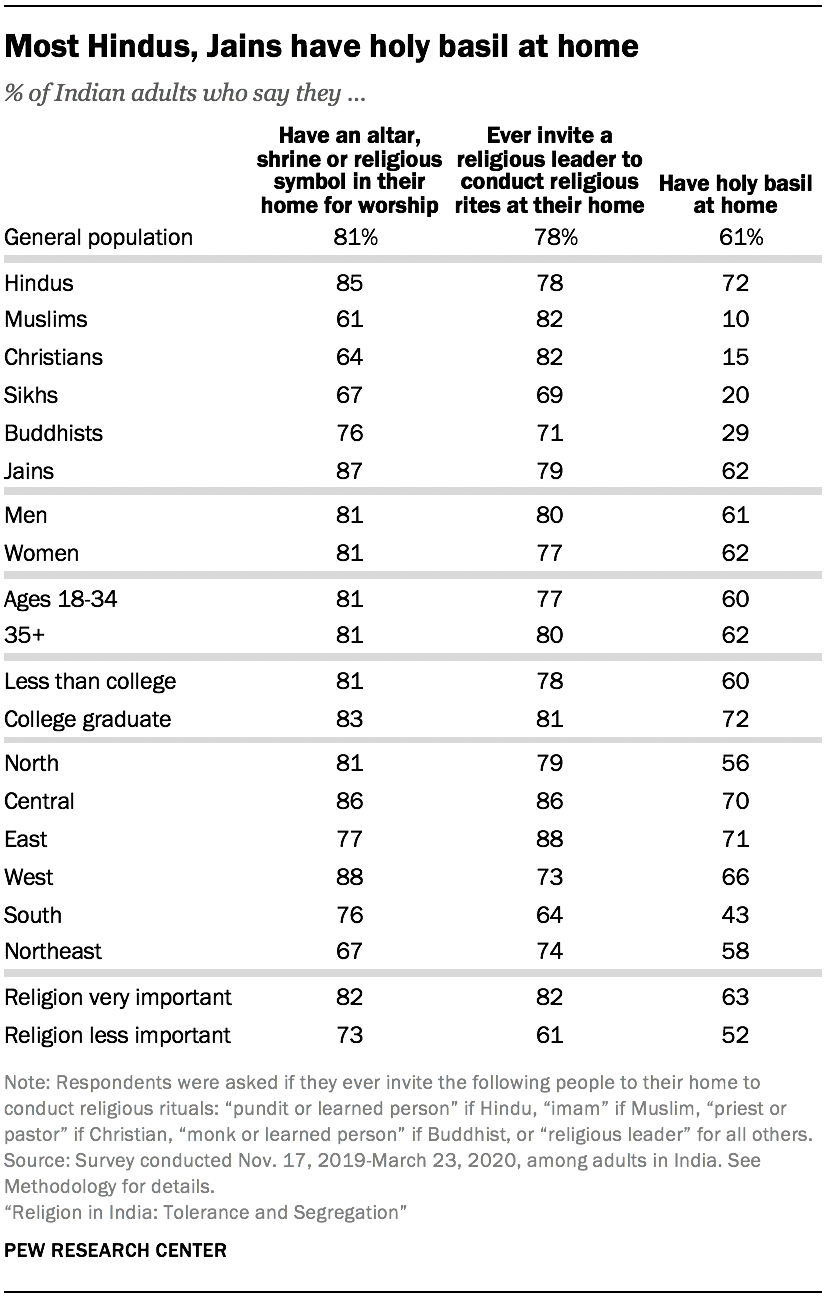 Puja is not the only home-based religious practice for many Indians. The survey also asked if Indians have an altar, shrine or religious symbol in their home for worship; if they ever invite religious leaders (e.g., a pundit, an imam, a priest or pastor, or a monk) to perform religious rites at their home; and if they have holy basil at home.
Puja is not the only home-based religious practice for many Indians. The survey also asked if Indians have an altar, shrine or religious symbol in their home for worship; if they ever invite religious leaders (e.g., a pundit, an imam, a priest or pastor, or a monk) to perform religious rites at their home; and if they have holy basil at home.
The vast majority of Indians (81%) say they have religious symbols in their home for worship, and a comparable share (78%) say they ever invite religious leaders into their home to conduct religious rites.
Overall, Hindus and Jains are the most likely to have altars, shrines or religious objects in their homes. This is especially true for holy basil (the tulsi plant), which is considered sacred in India – majorities of Hindus (72%) and Jains (62%) have tulsi at home, compared with about three-in-ten or fewer in other groups. Large majorities in all religious communities have invited a religious leader to their home for religious rituals.
Among Hindus, college graduates are more likely than other Hindus to have holy basil (80% vs. 71%). And college-educated Christians are much more likely than Christians with less education to keep an altar, shrine or religious symbol at home (77% vs. 62%).
Where people live also is linked with household practices. Southern Indians are less likely than Indians in other regions to invite religious leaders to their homes. Yet Indians in the Northeast are the least likely to have altars, shrines or religious symbols at home for worship.
Among Hindus, people in General Category castes are slightly more likely than lower-caste Hindus to have holy basil at home (77% vs. 70%).
Religious pilgrimages common across most religious groups in India
 In India, most adults (56%) say they have made a religious pilgrimage, and this is true across most religious groups. The majority of Muslims, however, say they have not made a pilgrimage (62%).
In India, most adults (56%) say they have made a religious pilgrimage, and this is true across most religious groups. The majority of Muslims, however, say they have not made a pilgrimage (62%).
Throughout the country, older adults are more likely than those ages 18 to 34 to have made a pilgrimage (61% vs. 49%). And those in the Northern (61%) and Central (65%) regions are generally more likely to have taken a pilgrimage. Meanwhile, the vast majority of Northeastern Indians have never taken one (81%).
Most Indians who say they pray daily have been on a pilgrimage (60%), compared with about half of Indians who pray less often (48%).
Among Muslims, those who recently have faced financial hardship (i.e., were unable to pay for food, medicine or housing in the last year) are slightly more likely than other Muslims to have made a pilgrimage (41% vs. 34%). And lower-caste Muslims also are more likely than General Category Muslims to have done this (42% vs. 33%).
Most Hindus say they have received purification from a holy body of water
 Nearly two-thirds of Hindus say they have received purification by taking a dip in a holy body of water, such as the Ganges River (65%). Far fewer Jains (40%), Sikhs (34%) and Buddhists (20%) say they have ever been purified in a holy body of water. (Muslims and Christians did not receive this question.)
Nearly two-thirds of Hindus say they have received purification by taking a dip in a holy body of water, such as the Ganges River (65%). Far fewer Jains (40%), Sikhs (34%) and Buddhists (20%) say they have ever been purified in a holy body of water. (Muslims and Christians did not receive this question.)
Older Hindus (ages 35 and older) are more likely than younger Hindu adults to have received purification in a holy body of water (69% vs. 60%).
Strong majorities of Hindus in the Eastern (64%), Northern (71%) and Central (81%) regions – through which the Ganges flows – say they have taken a dip in a holy body of water. But even in the South, most Hindus (63%) have received purification in this way.
Hindus who say religion is very important in their lives are significantly more likely than other Hindus to have taken a dip in a holy body of water (68% vs. 50%).
Roughly half of Indian adults meditate at least weekly
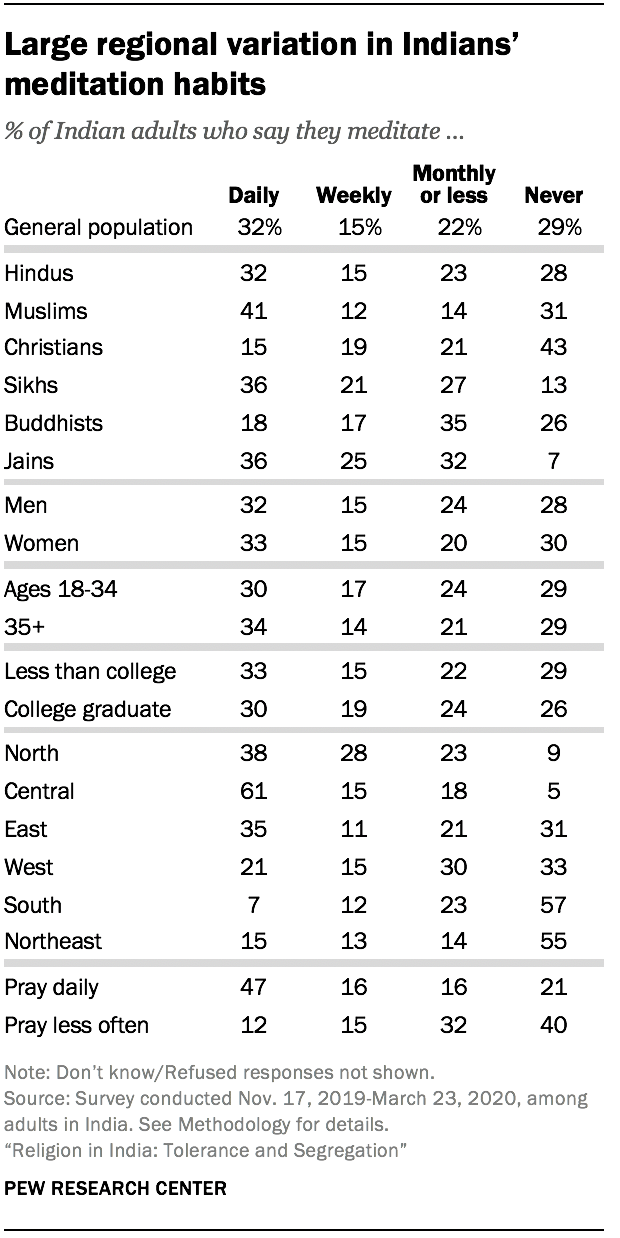 About half of Indian adults (48%) report meditating once a week or more, including nearly a third (32%) who do so daily. Most Sikhs (57%) and Jains (61%) say they practice meditation at least once a week, as do 52% of Muslims and 47% of Hindus. Fewer Christians (34%) and Buddhists (35%) meditate weekly.
About half of Indian adults (48%) report meditating once a week or more, including nearly a third (32%) who do so daily. Most Sikhs (57%) and Jains (61%) say they practice meditation at least once a week, as do 52% of Muslims and 47% of Hindus. Fewer Christians (34%) and Buddhists (35%) meditate weekly.
Indians who pray daily are more than twice as likely as other Indians to meditate at least once a week (62% vs. 26%).
Indians in different regions are drastically different in their meditation habits. About three-quarters of Indians in the Central region (76%) report that they meditate at least once a week, including a majority who meditate daily (61%). By contrast, only 19% of South Indians meditate at least weekly.
Only about a third of Indians ever practice yoga
 India is the birthplace of yoga, but most Indians do not practice it. About a third of Indians (35%) say they everpractice yoga, with just 13% doing so weekly or more often. Meanwhile, roughly six-in-ten (62%) – including an identical share of Hindus – say they never do yoga.
India is the birthplace of yoga, but most Indians do not practice it. About a third of Indians (35%) say they everpractice yoga, with just 13% doing so weekly or more often. Meanwhile, roughly six-in-ten (62%) – including an identical share of Hindus – say they never do yoga.
Jains are more likely than members of India's other major religious groups to practice yoga (61%), though many Sikhs (50%) do so as well. About a quarter of Jains and Sikhs say they do yoga at least weekly.
In India, those who do yoga tend to be relatively young, highly educated and disproportionately men. For instance, a majority of college-educated Indians (56%) practice yoga, compared with only a third of those with less education. And people in North India are more likely than Indians in other regions to ever practice yoga.
Indians who pray daily are slightly more inclined than other Indians to participate in yoga (38% vs. 30%). But on the whole, Indians who say religion is very important in their lives are not more likely than other Indians to do yoga. In fact, among Sikhs, those who say religion is very important are less likely than other Sikhs to ever practice yoga.
Nearly three-quarters of Christians sing devotionally
The survey also asked Indians whether they dance or sing devotionally. A slim majority of Indians (54%) say they sing devotionally, and about a quarter (27%) report dancing as a devotional practice.
Majorities of Christians (74%), Hindus (57%) and Jains (56%) say they sing devotionally.
On balance, older adults (ages 35 and older) are a little more likely than younger adults to say they sing devotionally. But older Indians are somewhat less likely than younger adults to dance devotionally (25% vs. 29%). College-educated Indians also are more likely to dance than those with less education (32% vs. 26%).
South Indians are less inclined than those in other regions to sing devotionally. Lower singing rates in the South are driven by Hindus; Southern Muslims and Christians sing devotionally at similar or higher rates compared with Muslims and Christians nationally.
Most Muslims and few Jains say they have participated in or witnessed animal sacrifice for religious purposes
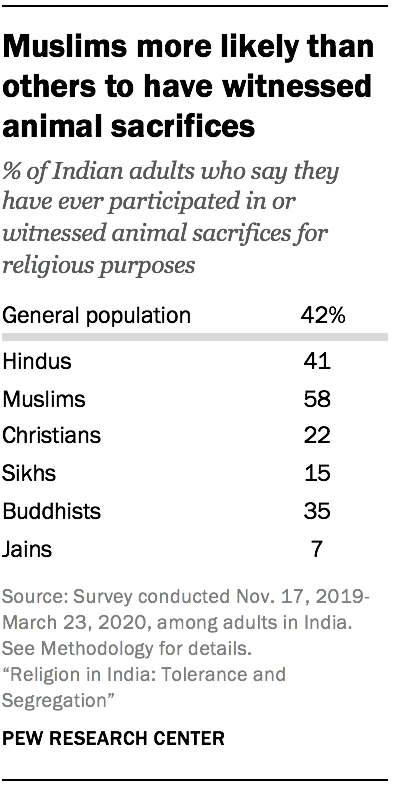
 While a majority of Indian Muslims (58%) say they have participated in or witnessed animal sacrifices for religious purposes, fewer than half of respondents in all of the country's other major religious communities have ever taken part in such practices. And among Jains, whose religion teaches that no harm should be done to any life form, just 7% of adults have witnessed or participated in animal sacrifices.
While a majority of Indian Muslims (58%) say they have participated in or witnessed animal sacrifices for religious purposes, fewer than half of respondents in all of the country's other major religious communities have ever taken part in such practices. And among Jains, whose religion teaches that no harm should be done to any life form, just 7% of adults have witnessed or participated in animal sacrifices.
A majority (65%) of Muslim men in India have witnessed an animal sacrifice for religious purposes (which could include the slaughter of a lamb or a goat for the Eid holiday, for example), compared with half of Muslim women (50%). Older Muslims, that is, those over the age of 34, are somewhat more likely than younger Muslims to have participated in or witnessed this ritual (61% vs. 55%). The practice is much less common among Muslims in the Northeast (24%) than elsewhere.
Hindus differ significantly by region on whether they have ever participated in or witnessed an animal sacrifice. Southern Hindus are the most likely to have ever participated in or witnessed animal sacrifices (65%), while those in the North are generally less likely to have engaged in this practice (25%).
Less-educated and poorer Hindus – those who report recently struggling to pay for necessities like shelter, health care or food – are more likely than other Hindus to have participated in or witnessed animal sacrifices.
Many Sikhs and Muslims follow a guru, pir or baba
The survey asked Indians if they follow a guru, pir or baba – spiritual guides or teachers common in most of India's major religious groups. Sikhs and Muslims are the most likely to say they follow a guru, pir or baba (57% and 53%, respectively). By contrast, majorities of Hindus (56%), Jains (58%), Buddhists (77%) and Christians (83%) say they do not follow these types of spiritual teachers.

More than half of Indians in the Central (55%) and Northern (54%) regions follow a spiritual teacher, but far fewer in the West (30%) and South (23%) say they do this. And rural Indians are more likely than urban Indians to follow a guru, pir or baba (45% vs. 35%).
Hindus who pray daily are more likely than others to follow a guru, pir or baba (47% vs. 33%). However, among Sikhs, those who pray daily are less likely than other Sikhs to follow a spiritual teacher (51% vs. 62%).
Most Indians schedule key life events based on auspicious dates
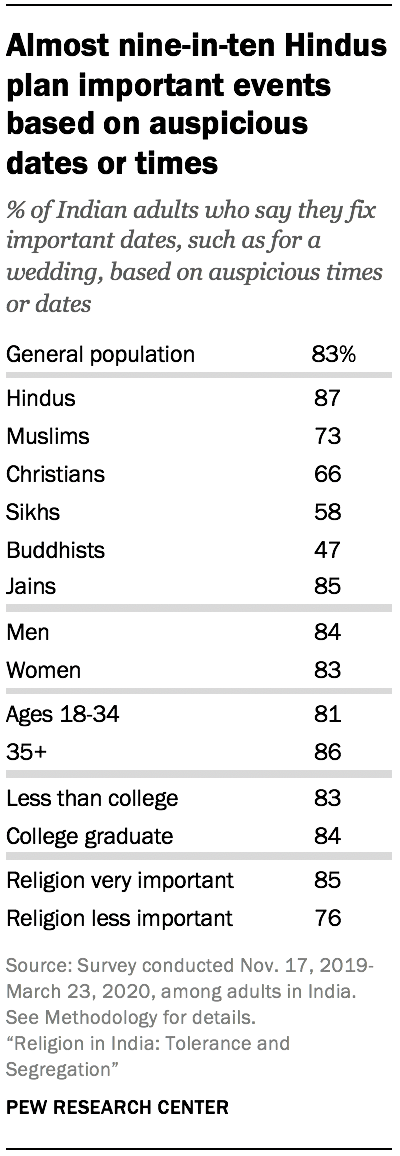 Respondents were asked if they fix important dates – such as for a wedding – based on auspicious times or dates. Majorities in most religious groups responded that they do, including the vast majority of Hindus (87%) and Jains (85%). Among Buddhists, far fewer (47%) say the same.
Respondents were asked if they fix important dates – such as for a wedding – based on auspicious times or dates. Majorities in most religious groups responded that they do, including the vast majority of Hindus (87%) and Jains (85%). Among Buddhists, far fewer (47%) say the same.
Planning for major life events in this way is very common among both men and women, Indians who are highly educated and those who are not, and older and younger Indian adults. Those who say religion is very important in their lives are somewhat more likely than others to fix dates based on auspicious times or dates (85% vs. 76%).
About half of Indians watch religious programs weekly
Roughly half of Indian adults (48%) say they watch religious programs or serials at least weekly. This is slightly lower than the share who watch other serials with this frequency (53%). Meanwhile, a clear majority of Indians (62%) watch the news at least weekly.
Sikhs (63%) and Jains (57%) are somewhat more likely than followers of other religions to watch religious programming on a weekly basis. Jains also are the most likely community to watch the news or other serial programming.
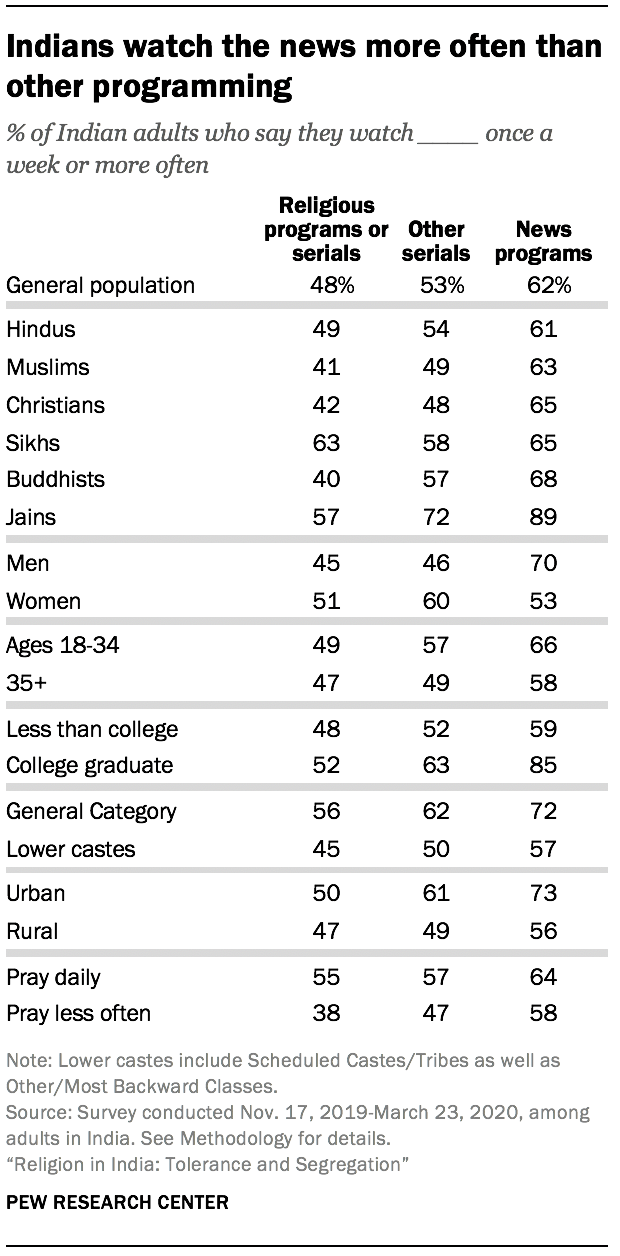 Most Indians in General Category castes (56%) watch religious programming at least weekly, compared with fewer in lower castes (45%). Among Christians, however, members of lower castes and those who have faced financial trouble are more likely than other Christians to watch religious programming weekly. For example, 49% of lower-caste Christians watch religious programming weekly, while about half as many General Category Christians report doing this (25%).
Most Indians in General Category castes (56%) watch religious programming at least weekly, compared with fewer in lower castes (45%). Among Christians, however, members of lower castes and those who have faced financial trouble are more likely than other Christians to watch religious programming weekly. For example, 49% of lower-caste Christians watch religious programming weekly, while about half as many General Category Christians report doing this (25%).
In general, college-educated Indians, younger adults (ages 18 to 34) and those who live in urban areas are slightly more inclined than other Indians to watch religious programs weekly.
While Indian women are more likely than men to watch religious programs or other serials at least weekly, men are much more likely than women to watch news programs.
Indians who pray daily tend to report higher viewership of not just religious programs and serials, but also other serials and the news. For example, 57% of Indians who pray daily watch other serial programs weekly, while 47% of other Indians do this.
For Hindus, nationalism associated with greater religious observance
Religious observances described throughout this chapter are common among Hindus regardless of partisanship and other political views. However, Hindus who have a favorable view of the BJP and those who express elements of Hindu nationalist sentiment tend to be more religiously observant.
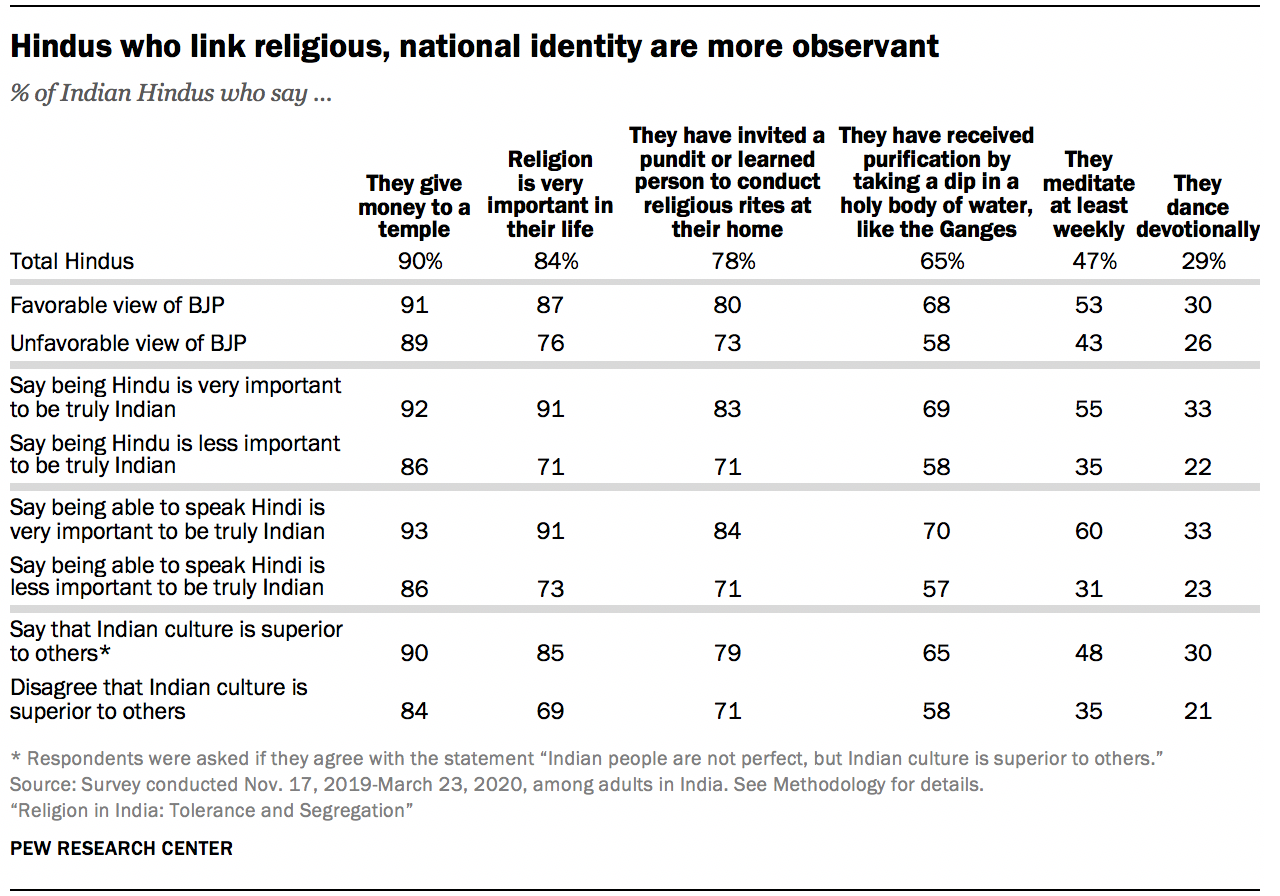
For instance, Hindus with a favorable view of the BJP are somewhat more likely than those who do not favor the party to have invited a religious leader to their home to conduct religious rites (80% vs. 73%). Hindus who see a strong connection between their religious and national identities also are more likely to participate in religious activities. For example, Hindus who say it is very important to be Hindu to be truly Indian are much more likely than other Hindus to say they meditate weekly or more often (55% vs. 35%).
Similarly, Hindus who place an emphasis on the Hindi language's role in Indian identity and those who view Indian culture as superior are much more inclined to engage in a range of religious practices.
Source: https://www.pewresearch.org/religion/2021/06/29/religious-practices-2/
0 Response to "In What Ways Does Religion Continue to Shape India Today"
Post a Comment